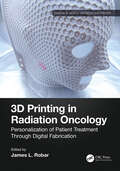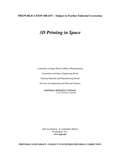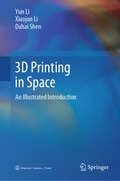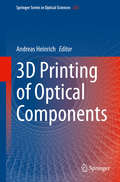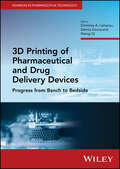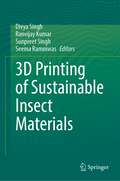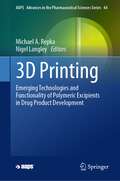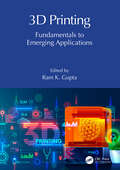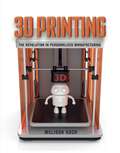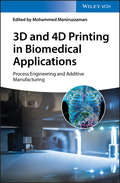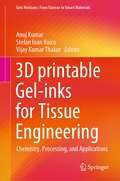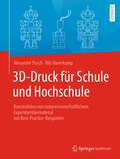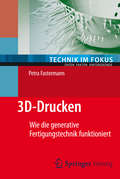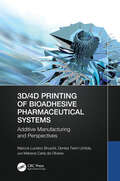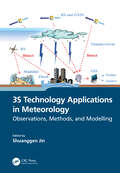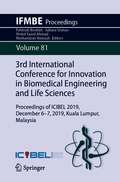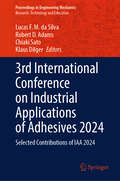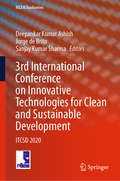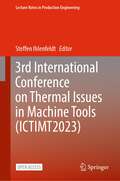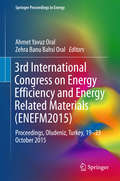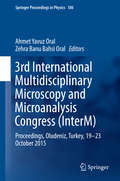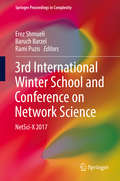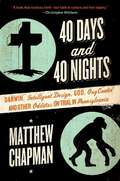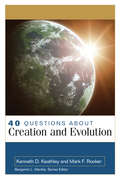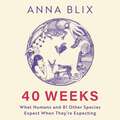- Table View
- List View
3D Printing in Radiation Oncology: Personalization of Patient Treatment Through Digital Fabrication (Imaging in Medical Diagnosis and Therapy)
by James L. Robar3D Printing in Radiation Oncology: Personalization of Patient Treatment Through Digital Fabrication presents a comprehensive and practical view of the many forms in which 3D printing is being integrated into radiation oncology practice. Radiation oncology employs among the most sophisticated digital technologies in medicine. Until recently, however, the “last mile” of treatment has required manually produced or generic devices for patient set up, positioning, control of surface dose, and delivery of brachytherapy treatment. 3D printing is already offering enhancements in both precision and efficiency through the digital design and fabrication of patient photon and electron bolus, customized surface and gynecological brachytherapy applicators, proton beam compensators and range shifters, patient immobilization, novel radiation detectors, and phantoms. Various innovations are disrupting decades-old practices in radiation therapy (RT) facilities, resulting in vital improvements in personalization of treatment and patient experience.An essential read for radiation oncologists, medical physicists, radiation therapists, oncology nurses, hospital administrators, engineers, and medical educators, this book is an indispensable resource for those bringing 3D printing to the RT clinic, looking to expand the role of 3D printing in their practice, or embarking upon related research and development.
3D Printing in Space
by Committee on Space-Based Additive ManufacturingAdditive manufacturing has the potential to positively affect human spaceflight operations by enabling the in-orbit manufacture of replacement parts and tools, which could reduce existing logistics requirements for the International Space Station and future long-duration human space missions. The benefits of in-space additive manufacturing for robotic spacecraft are far less clear, although this rapidly advancing technology can also potentially enable space-based construction of large structures and, perhaps someday, substantially in the future, entire spacecraft. Additive manufacturing can also help to reimagine a new space architecture that is not constrained by the design and manufacturing confines of gravity, current manufacturing processes, and launch-related structural stresses. The specific benefits and potential scope of additive manufacturing remain undetermined. The realities of what can be accomplished today, using this technology on the ground, demonstrate the substantial gaps between the vision for additive manufacturing in space and the limitations of the technology and the progress that has to be made to develop it for space use. "3D Printing in Space" evaluates the prospects of in-space additive manufacturing. This report examines the various technologies available and currently in development, and considers the possible impacts for crewed space operations and robotic spacecraft operations. Ground-based additive manufacturing is being rapidly developed by industry, and "3D Printing in Space" discusses government-industry investments in technology development. According to this report, the International Space Station provides an excellent opportunity for both civilian and military research on additive manufacturing technology. Additive manufacturing presents potential opportunities, both as a tool in a broad toolkit of options for space-based activities and as a potential paradigm-changing approach to designing hardware for in-space activities. This report makes recommendations for future research, suggests objectives for an additive manufacturing roadmap, and envisions opportunities for cooperation and joint development.
3D Printing in Space: An Illustrated Introduction
by Xiaojun Li Yun Li Dahai ShenThis book introduces an important and interesting aspect of space exploration technology: 3D printing in space. It explores the key techniques and application scenarios of this innovative technology. With several countries announcing moon missions, the dream of venturing into the vast universe is becoming a reality. 3D printing offers immense potential for space exploration efforts. Featuring over 100 color graphics, this book not only explains fundamental theories and research advances in an easily understandable way but also addresses practical questions like achieving "waste recycling" in spacecraft and printing "houses" on the moon's surface. Additionally, it provides insights on dealing with component failures during deep space missions. Drawing from the authors' extensive research and development work in satellite payload technology, this book combines solid theoretical knowledge with practical engineering experience. It is a valuable resource for students, researchers, and engineers interested in space exploration and astronautics. Let this book serve as a vessel for readers to embark on their journey through the sea of stars. The English translation of this book, originally in Chinese, was facilitated by artificial intelligence. The content was later revised by the author for accuracy.
3D Printing of Optical Components (Springer Series in Optical Sciences #233)
by Andreas HeinrichThis edited volume reviews the current state of the art in the additive manufacturing of optical componentry, exploring key principles, materials, processes and applications. A short introduction lets readers familiarize themselves with the fundamental principles of the 3D printing method. This is followed by a chapter on commonly-used and emerging materials for printing of optical components, and subsequent chapters are dedicated to specific topics and case studies. The high potential of additive manufactured optical components is presented based on different manufacturing techniques and accompanied with extensive examples – from nanooptics to large scale optics – and taking research and industrial perspectives. Readers are provided with an extensive overview of the new possibilities brought about by this alternative method for optical components manufacture. Finally, the limitations of the method with respect to manufacturing techniques, materials and optical properties of the generated objects are discussed. With contributions from experts in academia and industry, this work will appeal to a wide readership, from undergraduate students through engineers to researchers interested in modern methods of manufacturing optical components.
3D Printing of Pharmaceutical and Drug Delivery Devices: Progress from Bench to Bedside (Advances in Pharmaceutical Technology)
by Dennis Douroumis Dimitrios A. Lamprou Sheng Qi3D Printing of Pharmaceutical and Drug Delivery Devices 3D Printing of Pharmaceutical and Drug Delivery Devices Discover the latest, fast-developing technology to help move towards more cost-effective, small-batch, decentralized manufacturing of personalized systems 3D printing has revolutionized manufacturing. Its precision and flexibility have enabled the large-scale production of materials and devices too complex for conventional industrial manufacturing. This has been particularly revolutionary in the field of pharmaceutical production, where 3D printing is being integrated into the manufacture of both drugs and drug delivery devices. It has never been more important for industry professionals to understand this form of production. 3D Printing of Pharmaceuticals and Drug Delivery Devices: Progress from Bench to Bedside offers a comprehensive overview of 3D printing technology and its pharmaceutical applications. It introduces readers to a world in which bespoke drug delivery systems developed for specific users or conditions is rapidly becoming a reality. Its detailed coverage of strategies and industrial processes incorporates the latest research and real-world experience of production. 3D Printing of Pharmaceuticals and Drug Delivery Devices: Progress from Bench to Bedside readers will also find: A multi-disciplinary authorial team of industry leadersDiscussion of common technical and regulatory barriers and their possible solutionsFar-ranging discussion of pharmaceutical applications across all sectors 3D Printing of Pharmaceuticals and Drug Delivery Devices: Progress from Bench to Bedside is essential reading for pharmaceutical industry professionals and researchers looking to occupy the leading edge.
3D Printing of Sustainable Insect Materials
by Sunpreet Singh Ranvijay Kumar Divya Singh Seema RamniwasThis book compiles a diverse and interdisciplinary range of scientific literature, laboratory developments, industrial implications and future prospects covering Entomophagy in 3D food printing to fight against hunger and nutritional deficiencies. Recent developments in Entomphagy in 3D printing of Drosophila based materials, and their nutritional, social, economic, scientific and environmental aspects. are comprehensively covered. Readers will also find shortcomings, guidelines, and industrial prospects for these materials, with emphasis on processing methods for the extraction of sustainable materials through 3D food printing. 3D Printing of Sustainable Insect Materials focuses on the methodology, technology and processing used for utilizing insects in 3D food printing applications, establishing technology-driven knowledge to fight against hunger. Chapters cover the principles for Entomophagy, insect processing methods, modern 3D food printing technologies, and the theoretical and practical aspects of Emtomophagy in 3D printing, with a special focus on future prospects and technologies. This ground-breaking book will serve knowledge to researchers and industry professionals across the food industry with broad coverage of emerging technologies, materials developed through Entomophagy, functional characterization and the technical details required to produce sustainable insect-based materials through 3D food printing.
3D Printing: Emerging Technologies and Functionality of Polymeric Excipients in Drug Product Development (AAPS Advances in the Pharmaceutical Sciences Series #44)
by Michael A. Repka Nigel LangleyThis inclusive text describes 3D Printing for pharmaceutical applications, including emerging 3D technologies. The book focuses on the functionality of the materials/biomaterials used for the preparation of dosage forms and devices, fundamentals for preparing these systems and novel applications using these additive manufacturing techniques. Also, the text includes clinical relevance and regulatory considerations for the future of personalized medicine.Authored by experts with a broad range of experience, extensive insight into the science of 3D printing technology used to produce these systems is provided. Highlighting viewpoints from the academic, polymer excipient, equipment, product development and regulatory communities, this comprehensive text compiles input from industry thought leaders to illustrate strategies and technologies for applying techniques of additive manufacturing for drug product and device development while also providing insight into the path forward for the technology in years to come.
3D Printing: Fundamentals to Emerging Applications
by Ram K Gupta3D Printing: Fundamentals to Emerging Applications discusses the fundamentals of 3D-printing technologies and their emerging applications in many important sectors such as energy, biomedicals, and sensors. Top international authors in their fields cover the fundamentals of 3D-printing technologies for batteries, supercapacitors, fuel cells, sensors, and biomedical and other emerging applications. They also address current challenges and possible solutions in 3D-printing technologies for advanced applications. Key features: Addresses the state-of-the-art progress and challenges in 3D-printing technologies Explores the use of various materials in 3D printing for advanced applications Covers fundamentals of the electrochemical behavior of various materials for energy applications Provides new direction and enables understanding of the chemistry, electrochemical properties, and technologies for 3D printing This is a must-have resource for students as well as researchers and industry professionals working in energy, biomedicine, materials, and nanotechnology.
3D Printing: The Revolution in Personalized Manufacturing
by Melissa Koch3D printing was once only known through science fiction, such as Star Trek, the popular 1960s TV series. But inventors and engineers on Earth began experimenting in real life with 3D printing to find faster ways to develop and build prototypes, using computers, ultraviolet lasers, and printable materials. Now, there are many innovative uses for 3D printing. Yet 3D printing has drawbacks. Chemicals used in 3D printing can be toxic, and legal experts are not sure how to protect 3D printing inventions so that others do not steal ideas. Learn how 3D printing works and how we can keep up with the safety, health, and legal challenges that lie ahead.
3D and 4D Printing in Biomedical Applications: Process Engineering and Additive Manufacturing
by Mohammed ManiruzzamanA professional guide to 3D and 4D printing technology in the biomedical and pharmaceutical fields 3D and 4D Printing in Biomedical Applications offers an authoritative guide to 3D and 4D printing technology in the biomedical and pharmaceutical arenas. With contributions from an international panel of academic scholars and industry experts, this book contains an overview of the topic and the most current research and innovations in pharmaceutical and biomedical applications. This important volume explores the process optimization, innovation process, engineering, and platform technology behind printed medicine. In addition, information on biomedical developments include topics such as on shape memory polymers, 4D bio-fabrications and bone printing. The book covers a wealth of relevant topics including information on the potential of 3D printing for pharmaceutical drug delivery, examines a new fabrication process, bio-scaffolding, and reviews the most current trends and challenges in biofabrication for 3D and 4D bioprinting. This vital resource: -Offers a comprehensive guide to 3D and 4D printing technology in the biomedical and pharmaceutical fields -Includes information on the first 3D printing platform to get FDA approval for a pharmaceutical product -Contains a review of the current 3D printed pharmaceutical products -Presents recent advances of novel materials for 3D/4D printing and biomedical applications Written for pharmaceutical chemists, medicinal chemists, biotechnologists, pharma engineers, 3D and 4D Printing in Biomedical Applications explores the key aspects of the printing of medical and pharmaceutical products and the challenges and advances associated with their development.
3D printable Gel-inks for Tissue Engineering: Chemistry, Processing, and Applications (Gels Horizons: From Science to Smart Materials)
by Vijay Kumar Thakur Anuj Kumar Stefan Ioan VoicuThis book provides the necessary fundamentals and background for researchers and research professionals working in the field of 3D bioprinting in tissue engineering. In 3D bioprinting, design and development of the biomaterial-inks/bio-inks is a major challenge in providing 3D microenvironments specific to anatomical and architectural demands of native tissues. The focal point of this book is to provide the basic chemistry of biomaterials, updates on current processing, developments, and challenges, and recent advancements in tissue-specific 3D printing/bioprinting. This book is will serve as a go-to reference on bioprinting and is ideal for students, researchers and professionals, working academia, government, the medical industry, and healthcare.
3D-Druck für Schule und Hochschule: Konstruktion von naturwissenschaftlichem Experimentiermaterial mit Best-Practice-Beispielen
by Alexander Pusch Nils HaverkampDieses Buch führt Leserinnen und Leser durch vielfältige Einsatzmöglichkeiten von 3D-Druck und 3D-Konstruktion im Rahmen von naturwissenschaftlicher Lehre an Schule und Hochschule. Im ersten Teil beschäftigen sich die Autoren mit fachdidaktischen Hintergründen, insbesondere mit dem Einsatz von 3D-Druckern in Lernprozessen sowie mit Konstruktionskriterien und schulpraktischen Aspekten. Den Kern des Buches bilden 12 Best Practice-Beispiele zur Konstruktion von physikalischem Experimentiermaterial. Diese Anleitungen sind unterteilt in einfache Schritt-für-Schritt-Anleitungen mit Autodesk Tinkercad, fortgeschrittene Konstruktionen mit Autodesk Fusion 360 sowie Projektaufgaben. Die Bedienung und die Möglichkeiten der beiden verwendeten Programme werden jeweils vorab kurz vorgestellt.Das Buch richtet sich an Studierende des Lehramts, Dozierende, und Lehrkräfte, die sich im Rahmen ihres Unterrichts mit 3D-Druck und 3D-Konstruktion auseinandersetzen möchten. Auch Schülerinnen und Schülern sowie interessierten Laien werden Hilfestellung und Inspiration angeboten, 3D-Objekte zu planen, zu konstruieren und zu drucken. So werden Sie mit diesen Anleitungen unter anderem eine Finray-Zange, eine Magnetfeldsonde, gezinkte Würfel, eine Luftkissenscheibe, ein Katapult und den kleinen Roboter „Borsti 2.0“ konstruieren und drucken können. Die Best Practice-Beispiele im Buch sind auf Grundlage von Anleitungen aus Seminaren entstanden, in denen die Autoren für angehende Physiklehrkräfte Möglichkeiten, Nutzung, Tipps und Tricks vermitteln.
3D-Drucken: Wie die generative Fertigungstechnik funktioniert (Technik im Fokus)
by Petra FastermannWie funktioniert 3D-Druck? Wofür eignet sich welche 3D-Druck-Technologie? Was bedeutet 3D-Druck für den Einzelnen? Welche gesellschaftlichen und wirtschaftlichen Veränderungen wird es durch diese Zukunftstechnologie geben? Die Autorin gibt Antworten auf diese Fragen. Sie führt präzise und einfach in die immer populärer werdende Technologie des 3D-Drucks ein. Die Leser werden so in den Stand versetzt, 3D-Druck selbst anzuwenden. Sie lernen, kostenlose Software auszuprobieren oder vielleicht sogar in einer der immer zahlreicher werdenden offenen Werkstätten (FabLabs) einen 3D-Drucker selbst zu nutzen.
3D/4D Printing of Bioadhesive Pharmaceutical Systems: Additive Manufacturing and Perspectives
by Marcos Luciano Bruschi Denise Tiemi Uchida Mariana Carla de OliveiraThis book features a brief history of additive manufacturing and 3D/4D printing techniques, as well as the advantages, applications, and overall challenges facing the technology. It then focuses on the applications of bioadhesive systems for drug delivery.3D/4D Printing of Bioadhesive Pharmaceutical Systems: Additive Manufacturing and Perspectives, explores recent discoveries of 3D printing in the development of pharmaceutical systems and drug delivery. Specifically, it discusses the main polymers/materials used in the development of bio-adhesive pharmaceutical systems and explains the importance of bio-adhesiveness of drug release through 3D printing. The authors also introduce the main strategies necessary to achieve a proper drug delivery system through 3D printing, and examine the adhesiveness of these systems on the skin as the mucosa decreases with the elimination of the drug by the body. Finally, the book brings all the necessary specifications to obtain a bioadhesive system with suitable bio-ink to obtain the best 3D/4D printing.This book is written with the objective of helping students start their studies in pharmaceutical engineering, bioengineering and additive manufacturing. Moreover, engineering professionals can use the book to improve the performance of 3D/4D printers for this type of system.
3S Technology Applications in Meteorology: Observations, Methods, and Modelling
by Shuanggen JinSpatial information technology and its integration, such as remote sensing, geographic information systems (GIS), and global navigation satellite systems (GNSS), known as 3S technology, have been extensively utilized in managing and monitoring natural disasters. This book illustrates the 3S integrated applications in the field of meteorology and promotes the role of 3S in developing precise and intelligent meteorology. It presents the principles of 3S technology and the methods for monitoring different meteorological disasters and hazards as well as their application progress. The case studies from the United States, Japan, China, and Europe were conducted to help all countries understand the 3S technology functions in handling and monitoring severe meteorological hazards. FEATURES Presents integral observations from GNSS, GIS, and remote sensing in estimating and understanding meteorological changes Explains how to monitor and retrieve atmospheric parameter changes using GNSS and remote sensing Shows three-dimensional modelling and evaluations of meteorological variation processing based on GIS Helps meteorologists develop and use space-air-ground integrated observations for meteorological applications Illustrates the practices in monitoring meteorological hazards using space information techniques and case studies This book is intended for academics, researchers, and postgraduate students who specialize in geomatics, atmospheric science, and meteorology, as well as scientists who work in remote sensing and meteorology, and professionals who deal with meteorological hazards.
3rd International Conference for Innovation in Biomedical Engineering and Life Sciences: Proceedings of ICIBEL 2019, December 6-7, 2019, Kuala Lumpur, Malaysia (IFMBE Proceedings #81)
by Fatimah Ibrahim Juliana Usman Mohd Yazed Ahmad Norhamizan HamzahThis book presents innovative engineering solution for medical diagnosis, therapy and life science studies. Gathering the proceedings of the 3rd International Conference for Innovation in Biomedical Engineering and Life Sciences, ICIBEL 2020, held on December 6-7, 2019, in Kuala Lumpur, Malaysia, this book aims at informing on engineering tools and their clinical applications, and being a source of inspiration for future research and interdisciplinary collaborations.
3rd International Conference on Industrial Applications of Adhesives 2024: Selected Contributions of IAA 2024 (Proceedings in Engineering Mechanics)
by Robert D. Adams Chiaki Sato Lucas F. M. da Silva Klaus DilgerThis book offers selected papers presented at the 3rd International Conference on Industrial Applications of Adhesives, held in Cascais, Portugal, March 7-8, 2024. The goal of the conference was to provide a unique opportunity to exchange information, present the latest results as well as to discuss issues relevant to industrial applications of adhesives. Special contributions on formulation of adhesives, pressure sensitive adhesives, adhesive properties, design of adhesive joints, and durability of adhesive joints have been selected for this volume. This work will appeal to a wide readership, from practitioners through graduate students to researchers working in this field.
3rd International Conference on Innovative Technologies for Clean and Sustainable Development: ITCSD 2020 (RILEM Bookseries #29)
by Jorge De Brito Deepankar Kumar Ashish Sanjay Kumar SharmaThis book gathers peer-reviewed contributions presented at the 3rd International Conference on Innovative Technologies for Clean and Sustainable Development, held in Chandigarh, India, on February 19-21, 2020. The respective papers focus on sustainable materials science and cover topics including the durability and sustainability of concrete, green materials in construction, economics of cleaner production, environmental impact mitigation, innovative materials for sustainable construction, performance and sustainability of special concrete, renewable energy infrastructure, sustainability in road construction, sustainable concrete, sustainable construction materials, waste minimization & management, prevention and management of water pollution, and zero-energy buildings.
3rd International Conference on Thermal Issues in Machine Tools (Lecture Notes in Production Engineering)
by Steffen IhlenfeldtThis open access conference proceedings contains all the papers presented at the ICTIMT 2023, the 3rd International Conference on Thermal Issues in Machine Tools. The event takes place in Dresden, the capital of Saxony, from March 21-23 2023. The conference is organized by the Chair of Machine Tools Development and Adaptive Controls of the Technische Universität Dresden.
3rd International Congress on Energy Efficiency and Energy Related Materials: Proceedings, Oludeniz, Turkey, 19–23 October 2015 (Springer Proceedings in Energy)
by Ahmet Yavuz Oral Zehra Banu Bahsi OralThe 3rd International Congress on Energy Efficiency and Energy Related Materials (ENEFM2015) was held from 19-23 October 2015. This congress focused on the latest developments of sustainable energy technologies, materials for sustainable energy applications and environmental and economic perspectives of energy. These proceedings included 40 peer-reviewed technical papers, submitted by leading academic and research institutions from over 23 countries and represented some of the most cutting-edge researches available. The sections included in the 40 papers are listed as follows: Solar Energy, Fuel cells, Hydrogen productions, Hydrogen storage, Energy storage, Energy saving, Biofuels and Bioenergy, Wind Energy, Nuclear Energy, Fossil Energy, Hydropower, Carbon capture and storage, Materials for renewable energy storage and conversion, Photovoltaics and solar cells, Fuel generation from renewables (catalysis), Carbon dioxide sequestration and conversion, Materials for energy saving, Thermoelectrics, Energy saving in buildings, Bio-Assessment and Toxicology, Air pollution from mobile and stationary sources, Transport of Air Pollutants, Environment-Friendly Construction and Development, Energy Management Systems.
3rd International Multidisciplinary Microscopy and Microanalysis Congress: Proceedings, Oludeniz, Turkey, 19-23 October 2015 (Springer Proceedings in Physics #186)
by Ahmet Yavuz Oral Zehra Banu Bahsi OralThe 3rd International Multidisciplinary Microscopy Congress (InterM2015), held from 19 to 23 October 2015, focused on the latest developments concerning applications of microscopy in the biological, physical and chemical sciences at all dimensional scales, advances in instrumentation, techniques in and educational materials on microscopy. These proceedings gather 17 peer-reviewed technical papers submitted by leading academic and research institutions from nine countries and representing some of the most cutting-edge research available.
3rd International Winter School and Conference on Network Science: NetSci-X 2017 (Springer Proceedings in Complexity)
by Erez Shmueli Baruch Barzel Rami PuzisThis book contains original research chapters related to the interdisciplinary field of complex networks spanning biological and environmental networks, social, technological, and economic networks. Many natural phenomena can be modeled as networks where nodes are the primitive compounds and links represent their interactions, similarities, or distances of sorts. Complex networks have an enormous impact on research in various fields like biology, social sciences, engineering, and cyber-security to name a few. The topology of a network often encompasses important information on the functionality and dynamics of the system or the phenomenon it represents. Network science is an emerging interdisciplinary discipline that provides tools and insights to researchers in a variety of domains. NetSci-X is the central winter conference within the field and brings together leading researchers and innovators to connect, meet, and establish interdisciplinary channels for collaboration. It is the largest and best known event in the area of network science. This text demonstrates how ideas formulated by authors with different backgrounds are transformed into models, methods, and algorithms that are used to study complex systems across different domains and will appeal to researchers and students within in the field.
40 Days and 40 Nights: Darwin, Intelligent Design, God, Oxycontin®, and Other Oddities on Trial in Pennsylvania
by Matthew ChapmanIn this fascinating story of evolution, religion, politics, and personalities, Matthew Chapman captures the story behind the headlines in the debate over God and science in America.Kitzmiller v. Dover Board of Education, decided in late 2005, pitted the teaching of intelligent design (sometimes known as "creationism in a lab coat") against the teaching of evolution. Matthew Chapman, the great-great-grandson of Charles Darwin, spent several months covering the trial from beginning to end. Through his in-depth encounters with the participants—creationists, preachers, teachers, scientists on both sides of the issue, lawyers, theologians, the judge, and the eleven parents who resisted the fundamentalist proponents of intelligent design—Chapman tells a sometimes terrifying, often hilarious, and above all moving story of ordinary people doing battle in America over the place of religion and science in modern life.
40 Questions About Creation and Evolution (40 Questions & Answers Series)
by Kenneth Keathley Mark F. RookerBiblically and scientifically informed answers to pressing questions about the creation-evolution debateThis accessible volume evenly addresses the issues of modern science and the scriptural texts. The conservative evangelical authors are well-informed on contemporary scientific views of the universe and also carefully exegete the biblical texts that pertain to creation. They irenically consider the various angles of the debate and make constructive suggestions to reconcile science and the Bible.Those who are curious about the origins of life and the universe will want to read this book. Seminary students and serious college students will find this information critical, as an understanding of creation is vital to an effective apologetic in sharing the faith.
40 Weeks: What Humans and 81 Other Species Expect When They're Expecting
by Anna BlixMatrescene meets the Golden Mole - discover what the animal kingdom expects when it's expectingIt takes 40 weeks to grow a human baby. And the relationship between a foetus and a pregnant woman is a little like that of a parasite and its host. One takes and takes, while the other continues to give, risking their health in the process.Is there a better way?The Komodo dragon can reproduce via pathogenesis - fertilising its own eggs, so no male is needed.The Surinam toad harbours live babies in craters under its skin - until they're ready to burst out into the world. And the hyena . . . Well, best not mention the hyena . . .Anna Blix takes the reader on a fascinating journey through her own pregnancy, introducing us in each of the 40 weeks to other creatures who have just delivered their next generation into the world. This fun, informative and personable book provides evolutionary comfort throughout the long haul of pregnancy, and an explanation as to how we ended up here: as the smartest species with a tiresome, but perhaps not so bad way to reproduce. It could always be worse. Just ask the hyena.Translated from the Norwegian by Nicola Smalley
